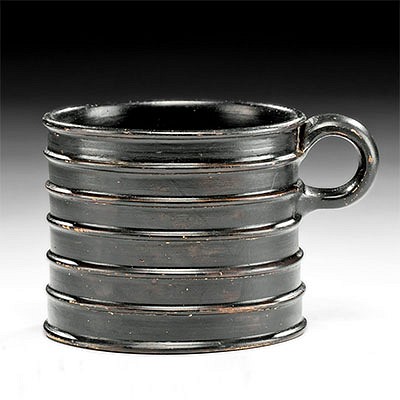9th C. Viking Twisted Silver Torc / Necklace
Lot 54e
About Seller
Artemis Fine Arts
686 S Taylor Ave, Ste 106
Louisville, CO 80027
United States
Selling antiquities, ancient and ethnographic art online since 1993, Artemis Gallery specializes in Classical Antiquities (Egyptian, Greek, Roman, Near Eastern), Asian, Pre-Columbian, African / Tribal / Oceanographic art. Our extensive inventory includes pottery, stone, metal, wood, glass and textil...Read more
Categories
Estimate:
$2,000 - $3,000
Absentee vs Live bid
Two ways to bid:
- Leave a max absentee bid and the platform will bid on your behalf up to your maximum bid during the live auction.
- Bid live during the auction and your bids will be submitted real-time to the auctioneer.
Bid Increments
| Price | Bid Increment |
|---|---|
| $0 | $25 |
| $300 | $50 |
| $1,000 | $100 |
| $2,000 | $250 |
| $5,000 | $500 |
| $10,000 | $1,000 |
| $20,000 | $2,500 |
| $50,000 | $5,000 |
| $100,000 | $10,000 |
| $200,000 | $20,000 |
About Auction
By Artemis Fine Arts
Mar 12, 2020
Set Reminder
2020-03-12 10:00:00
2020-03-12 10:00:00
America/New_York
Bidsquare
Bidsquare : Ancient / Ethnographic Around The World
https://www.bidsquare.com/auctions/artemis-gallery/ancient-ethnographic-around-the-world-4957
Ancient art from Egypt, Greece, Italy and the Near East, as well as Asian, Fossils, Pre-Columbian, Native American, African / Tribal / Oceanic, Spanish Colonial, Russian Icons, Fine art, much more! Artemis Fine Arts info@artemisfinearts.com
Ancient art from Egypt, Greece, Italy and the Near East, as well as Asian, Fossils, Pre-Columbian, Native American, African / Tribal / Oceanic, Spanish Colonial, Russian Icons, Fine art, much more! Artemis Fine Arts info@artemisfinearts.com
- Lot Description
Northern Europe, Viking or Norse culture, ca. 9th to 11th century CE. A gorgeous crescent-shaped necklace formed from a single elongated strip of silver (90%) with a twisting body boasting four coiling striations along the length and flattened ends terminating in diamond-shaped tips. Repeating Z-form registers as well as circular and zigzagging motifs are stamped atop each terminal and creates an image of an abstract two-headed serpent, perhaps representative of Jörmungandr, the World Serpent. Size: 5.2" Diameter (13.2 cm); quality of silver: 90%; total weight: 52.8 grams.
The serpent form may relate to the Norse myth of Jörmungandr (Jormungand), the Midgard Serpent, a child of Loki and a giantess who according to legend grew so large that it was able to surround the earth and grasp its own tail, forming an ouroboros. According to legend, when it releases its tail, Ragnarok, the final battle of the gods that will result in Earth becoming completely covered in water, will begin. One of the most popular motifs in Norse art concerns the story of Thor and Jörmungandr. In classic Thor style, he sets off on a reckless fishing expedition, taking the head of an ox as his bait, and sails further out to sea than he should. With a large hook and the ox head, he catches Jörmungandr, who surfaces, poison and blood dripping from his mouth. Thor's fishing companion, the giant Hymir, quickly cuts Thor's line before he can slay the serpent with his hammer and Jörmungandr sinks beneath the waves, the threat at bay - for the moment. Multiple Viking picture stones have been found depicting this story, including one from as early as the late 8th century.
The important Viking metalworking shops correspond to their great trading ports and proto-urban centers - Birka, Helgo, Sigtuna, and Lund in Sweden, Ribe, Haithabu (Hedeby), and Fyrkat in Denmark, and Kaupang and Trondheim in Norway. Silver was the principal currency of the Viking world, which stretched from Russia to northern Canada at the height of their influence. In many places, the Vikings kept silver not as coins, but as jewelry, a wearable currency form that was not subject to the authority of a monarch or mint. One of the most common archaeological finds from the Viking period is a hoard of metal objects, often buried in the earth or deposited in bodies of water, like river beds.
Provenance: private California, USA collection; ex-New York, USA numismatic show at World Trade Show, 1990s
All items legal to buy/sell under U.S. Statute covering cultural patrimony Code 2600, CHAPTER 14, and are guaranteed to be as described or your money back.
A Certificate of Authenticity will accompany all winning bids.
We ship worldwide and handle all shipping in-house for your convenience.
#146081Wearable as shown. Slight bending to overall form, and light softening to some hammered motifs, otherwise intact and excellent. Light earthen deposits within some recessed areas, and fine patina throughout.Condition
- Shipping Info
-
All shipping is handled in-house for your convenience. Your invoice from Artemis Gallery will include shipping calculation instructions. If in doubt, please inquire BEFORE bidding for estimated shipping costs for individual items.
-
- Buyer's Premium



 EUR
EUR CAD
CAD AUD
AUD GBP
GBP MXN
MXN HKD
HKD CNY
CNY MYR
MYR SEK
SEK SGD
SGD CHF
CHF THB
THB














